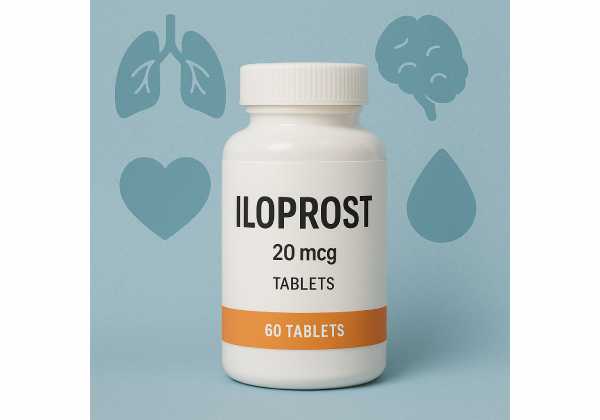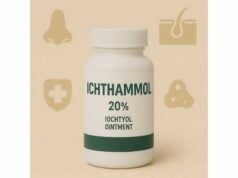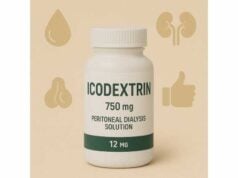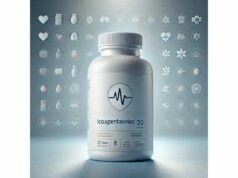
Iloprost is a synthetic analogue of prostacyclin (PGI₂), a naturally occurring molecule that dilates blood vessels, reduces platelet stickiness, and helps protect the lining of arteries. Clinically, it is used by inhalation for pulmonary arterial hypertension (PAH) and by intravenous infusion for severe peripheral ischemia, Raynaud’s phenomenon, and systemic sclerosis–related digital ulcers in certain settings. In 2024, an intravenous form also gained approval to reduce risk of amputation after severe frostbite. Because iloprost acts quickly and wears off fast, treatment often involves multiple inhalations per day or carefully titrated infusions. This guide translates the technical details into plain language: what iloprost does, who it helps, how to use it correctly, what doses are typical, how to avoid mistakes, and when to seek medical advice. You will also find a concise evidence snapshot to help place iloprost among other prostacyclin-pathway therapies.
Quick Overview
- Inhaled iloprost improves exercise capacity and symptoms in pulmonary arterial hypertension.
- Intravenous iloprost supports healing of ischemic digital ulcers in systemic sclerosis and treats severe frostbite.
- Typical PAH inhaled dose is 2.5–5 micrograms per session, 6–9 times daily.
- Main cautions: hypotension, bleeding risk (antiplatelet action), and bronchospasm in reactive airway disease.
- Avoid or use specialist oversight in pregnancy, severe hypotension, active bleeding, or if combining with strong vasodilators.
Table of Contents
- What iloprost is and how it works
- Who benefits from iloprost?
- How to use iloprost correctly
- How much iloprost per day?
- Safety, interactions, and who should avoid it
- Evidence snapshot and comparisons
What iloprost is and how it works
Iloprost is a laboratory-made version of prostacyclin, a signaling molecule produced by blood vessel lining cells. Prostacyclin attaches to the IP receptor on vascular smooth muscle and platelets. When this receptor is activated, it raises intracellular cyclic AMP (cAMP), which relaxes smooth muscle (vasodilation), inhibits platelet aggregation, and can lessen vascular inflammation. These actions are particularly relevant in diseases characterized by vasoconstriction, endothelial dysfunction, and microthrombotic risk.
Key pharmacology points:
- Rapid onset, short duration: Inhaled iloprost begins working within minutes and typically wears off in about an hour. Intravenous infusion produces steady effects but must be carefully titrated to avoid hypotension.
- Pulmonary selectivity with inhalation: Aerosol delivery targets the lung vasculature, improving ventilation–perfusion matching in PAH. This often reduces breathlessness and can improve exercise endurance.
- Antiplatelet effect: By raising cAMP inside platelets, iloprost reduces their tendency to clump. This helps microcirculatory flow but also increases bleeding risk, especially when combined with other antiplatelets or anticoagulants.
- Endothelial support: Iloprost may protect endothelial cells and improve microvascular perfusion, which is why it is used in systemic sclerosis–related digital ulcers and acute frostbite.
Formulations and routes:
- Inhaled solution delivered via specific nebulizers (e.g., I-Neb, Breelib) for PAH.
- Intravenous solution administered in specialist settings for systemic sclerosis vascular complications, critical limb ischemia in some regions, and frostbite.
- Not oral: There is no effective oral iloprost product; oral prostacyclin-pathway drugs belong to different classes (e.g., IP receptor agonists such as selexipag).
Because iloprost’s benefits depend on maintaining effect through the day, dosing schedules emphasize either multiple inhalations or controlled infusion cycles. The best route and regimen hinge on the condition being treated, comorbidities, and patient tolerance.
Who benefits from iloprost?
Iloprost’s main role is in diseases where abnormal narrowing of blood vessels and endothelial dysfunction drive symptoms and long-term harm. The clearest beneficiaries include:
- Pulmonary Arterial Hypertension (PAH): Inhaled iloprost is used to improve exercise capacity and symptomatic burden in WHO Group 1 PAH. It can be prescribed as an add-on to foundational therapy (e.g., endothelin receptor antagonists, phosphodiesterase-5 inhibitors/soluble guanylate cyclase stimulators) or considered in patients needing a prostacyclin-pathway agent but unable to manage continuous parenteral infusions. Its rapid, targeted vasodilation in the lung may improve hemodynamics and functional class when taken regularly throughout waking hours.
- Systemic sclerosis (SSc) vascular complications: Intravenous iloprost is used in many centers to treat refractory Raynaud’s phenomenon and ischemic digital ulcers. By improving microvascular blood flow and countering vasospasm, iloprost can reduce pain, promote ulcer healing, and lower recurrence risk. Treatment is typically delivered as cyclical infusions under rheumatology/vascular supervision.
- Severe frostbite: An intravenous iloprost product has been approved in the United States specifically to reduce amputation risk after severe frostbite. Here, iloprost supports microcirculation in damaged tissues, complementing rapid rewarming and wound care in hospital settings.
- Other vasculopathies (select settings): In some regions, iloprost may be used in specialized protocols for critical limb ischemia or peripheral arterial occlusive disease when revascularization options are limited and ischemic rest pain or ulcers persist. Such use is center-dependent and typically follows national or regional guidance.
Who may not be ideal candidates:
- Patients who cannot adhere to frequent inhalations (6–9 sessions/day) may struggle with inhaled therapy.
- People with uncontrolled hypotension, recent bleeding, or severe obstructive lung disease may face higher risks and require alternative options.
- Those already benefiting from parenteral prostacyclin (e.g., epoprostenol, treprostinil) may not gain from switching unless there is a compelling reason (tolerability, logistics).
Position among alternatives:
- The prostacyclin pathway can be addressed by inhaled, intravenous/subcutaneous, or oral IP-receptor agonists. Choice reflects disease severity, risk profile, and patient preference. In advanced PAH, guidelines often support combination therapy, with escalation to parenteral prostacyclin for high-risk disease. Iloprost is one tool within this framework, valued for inhaled pulmonary selectivity or for IV microvascular rescue in select systemic diseases.
How to use iloprost correctly
Correct use determines success. Because iloprost’s effect is brief, regularly spaced inhalations (for PAH) or carefully titrated infusions (for IV indications) are essential.
For inhaled iloprost (PAH):
- Device training: Use only the nebulizers specified for your product. Each device delivers a set microgram dose to the mouthpiece; switching devices without medical oversight can change delivered dose and side effects.
- Start low, then adjust: Initiation often uses 2.5 micrograms per session to check tolerance (dizziness, flushing, jaw pain, cough). If tolerated, clinicians usually increase to 5 micrograms per session.
- Session frequency: Plan 6–9 sessions during waking hours, spacing them roughly every 2–3 hours to maintain symptom control.
- Breathing technique: Sit upright. Inhale steadily through the mouthpiece; avoid breath-holding or forced inhalation that can trigger cough.
- Before exertion: If cleared by your clinician, time a session 15–30 minutes before exertion (e.g., walking test, planned activity) to leverage peak effect.
- Illness or missed doses: If a dose is missed, take the next session at the usual time. Do not “double” sessions. During respiratory infections or worsening breathlessness, contact your PAH team; they may temporarily adjust regimens.
- Environment: Because inhalation can cause cough, use in a calm place. Keep equipment clean to reduce infection risk.
For intravenous iloprost (systemic sclerosis digital ulcers, severe Raynaud’s, frostbite, selected vasculopathies):
- Specialist setting only: IV iloprost requires hospital or infusion center oversight with trained staff and hemodynamic monitoring.
- Dose titration: Infusions typically start at a very low rate and are titrated to effect and tolerance, balancing improved perfusion against symptoms like headache, flushing, or hypotension.
- Cycle structure: Many centers deliver daily infusions over several days (e.g., 3–7 days) for a treatment cycle, with repeat cycles based on response. Severe frostbite protocols follow specific timing relative to rewarming and surgical evaluation.
- Vascular access and safety: Use reliable IV access and watch closely for blood pressure drops. Because iloprost can inhibit platelets, care teams track for bleeding, especially in patients on anticoagulation.
- Concomitant therapy: In systemic sclerosis, iloprost often complements vasodilators (e.g., calcium channel blockers) and ulcer care (warming, wound protocols). For PAH, inhaled iloprost is usually layered onto background disease-targeted therapy rather than used alone in higher-risk patients.
Everyday practical tips:
- Keep hydrated, rise slowly from sitting, and avoid hot showers right after dosing to reduce dizziness.
- Track headache, flushing, cough, jaw pain, and blood pressure readings if advised. Share patterns with your care team; small changes in timing or dose can improve tolerability.
- Review all medications and supplements with your clinician to flag interaction risks (antiplatelets, anticoagulants, nitrates, PDE-5 inhibitors, antihypertensives).
How much iloprost per day?
Inhaled (PAH):
- Per session: Common initiation is 2.5 micrograms delivered at the mouthpiece. If well tolerated, most patients increase to 5 micrograms per session.
- Sessions per day: 6 to 9 sessions spaced during waking hours (approximately every 2–3 hours) are standard.
- Device-specific delivery: The nebulizer system is calibrated to deliver the stated dose; session duration may vary by device and concentration. Never alter the device or concentration without clinical guidance.
- Hepatic or severe renal impairment: Initial schedules may use longer intervals (e.g., every 3–4 hours, up to 6 sessions/day) to avoid accumulation, then cautiously shorten intervals if tolerated.
Intravenous (specialist indications):
- Titrated rates: Infusions are started at very low rates and increased carefully based on symptoms and blood pressure. Centers adopt weight-based protocols and ceiling rates individualized to tolerance.
- Cycle length: For systemic sclerosis–related digital ulcers, treatment often consists of daily infusions over several days per cycle (commonly 3–7 days), with repetition guided by response and re-ulceration risk.
- Frostbite: Hospital protocols integrate iloprost infusion soon after rapid rewarming and alongside surgical assessment to reduce amputation risk; exact timing and duration follow the labeled schedule and local pathways.
Therapeutic adjustments:
- If inhaled 5 micrograms triggers excessive cough, dizziness, or jaw pain, stepping back to 2.5 micrograms may restore tolerability.
- For day-to-day fluctuations (e.g., heat, dehydration, diuretics), clinicians may recommend slightly longer spacing between inhalations.
- Worsening PAH risk features (syncope, signs of right heart failure) signal the need for urgent reassessment; escalation to parenteral prostacyclin or combination intensification may be indicated.
Never self-change route, device, concentration, or infusion rate. All modifications should be planned with your specialist team after a structured review of symptoms, vitals, and comedications.
Safety, interactions, and who should avoid it
Common adverse effects:
- Headache, flushing, jaw pain, limb pain: Reflect vasodilation and usually lessen as you adapt.
- Cough and throat irritation (inhaled): Use a measured, steady inhalation. Mention any history of hyperreactive airways.
- Dizziness or lightheadedness: Stand up slowly; measure blood pressure during initiation if advised.
- Nausea: Small snacks and hydration can help.
Less common but important:
- Hypotension and syncope: Risk rises with dehydration, alcohol, fever, or concurrent antihypertensives/vasodilators.
- Bleeding: Because iloprost reduces platelet aggregation, bruising or bleeding risk increases, especially with antiplatelets (e.g., aspirin, clopidogrel) and anticoagulants (e.g., warfarin, DOACs).
- Bronchospasm: Rare but relevant in asthma/COPD; report wheeze or chest tightness promptly.
- Worsening right heart failure: Signals inadequate disease control rather than a drug side effect; requires immediate clinical review.
Medication and lifestyle interactions:
- Nitrates or nitric oxide donors, other prostacyclins/IP agonists, and PDE-5 inhibitors can amplify hypotension. Many patients with PAH are on combination therapy; this is intentional but requires specialist supervision.
- Antihypertensives (ACE inhibitors, ARBs, beta-blockers, diuretics): monitor blood pressure more closely during initiation or up-titration.
- Alcohol and hot environments can magnify vasodilation and dizziness.
- Procedures and dental work: Tell providers you use iloprost due to bleeding risk.
Who should avoid or seek specialist caution:
- Active bleeding, recent hemorrhagic stroke, or high bleeding risk conditions.
- Severe hypotension or uncontrolled volume depletion.
- Pregnancy and breastfeeding: Discuss potential fetal/neonatal risks and alternatives; plans should be individualized by maternal–fetal medicine and the treating specialist.
- Severe hepatic impairment or dialysis: Requires cautious initiation and extended dosing intervals (for inhaled) to avoid accumulation; IV use demands close monitoring.
When to call your care team urgently:
- Fainting episodes, chest pain, rapidly worsening breathlessness, severe persistent cough or wheeze after dosing, black/tarry stools, or significant nose/gum bleeding.
- New ulcers, color changes, or severe pain in fingers/toes if treated for systemic sclerosis or frostbite—these may need rapid reassessment.
Evidence snapshot and comparisons
Pulmonary Arterial Hypertension (PAH): Contemporary European guidelines include inhaled iloprost among prostacyclin-pathway options for symptomatic improvement in PAH, typically layered onto background therapy. Inhaled delivery targets pulmonary vasculature, which can improve functional class and 6-minute walk distance in selected patients. For those at intermediate-high or high risk, parenteral prostacyclin (e.g., epoprostenol or treprostinil) often provides stronger outcome benefit; inhaled iloprost may still play a role when pump therapy is not feasible or as part of a combination strategy.
Systemic sclerosis vascular disease: Intravenous iloprost is widely used for refractory Raynaud’s phenomenon and digital ulcers. Studies and guideline updates highlight benefits for pain relief and ulcer healing, especially when delivered over several consecutive days per cycle. It is frequently combined with vasodilators (e.g., calcium channel blockers, PDE-5 inhibitors) and wound care—an integrated approach that reduces recurrence and complications.
Severe frostbite: The U.S. approval of an IV iloprost product specifically for frostbite reflects growing evidence that improving microcirculation early reduces tissue loss. Protocols emphasize hospital-based care, rapid rewarming, and close surgical collaboration.
Compared with other prostacyclin-pathway therapies:
- Inhaled iloprost offers pulmonary targeting without indwelling catheters but requires frequent daily sessions.
- Parenteral prostacyclins (IV or subcutaneous) deliver continuous effect and stronger hemodynamic impact but involve pumps/catheters and infusion site challenges.
- Oral IP-receptor agonists (e.g., selexipag) provide convenient dosing but are pharmacologically distinct and may be combined with or substituted for inhaled options depending on risk tier and tolerance.
Key takeaways from the evidence landscape:
- Delivery route drives both practicality and potency; match the route to disease severity and lifestyle.
- In SSc digital ulcers, multi-day infusion courses appear to improve healing metrics versus shorter exposure in observational cohorts, supporting cyclical protocols in practice.
- Safety hinges on hemodynamic monitoring and bleeding vigilance, especially when treatment is combined with other vasodilators or antithrombotics.
References
- DailyMed – VENTAVIS- iloprost solution 2022 (Label)
- AURLUMYN (iloprost) injection, for intravenous use 2024 (Label)
- 2022 ESC/ERS Guidelines for the diagnosis and treatment of pulmonary hypertension 2022 (Guideline)
- Ventavis, INN-iloprost 2023 (Product Information)
- EULAR recommendations for the treatment of systemic sclerosis 2025 (Guideline)
Disclaimer
This article is for educational purposes and does not replace personalized medical advice, diagnosis, or treatment. Iloprost requires specialist evaluation, careful dosing, and monitoring. Do not start, stop, or change any medication without guidance from your qualified healthcare professional. If you experience warning symptoms such as fainting, chest pain, severe bleeding, or rapidly worsening breathlessness, seek urgent medical care.
If you found this guide useful, please consider sharing it on Facebook, X (formerly Twitter), or your preferred platform, and follow us for future updates. Your support helps us continue producing carefully researched, people-first health content.










